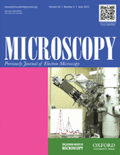
Microscopy
Scope & Guideline
Illuminating the Future of Imaging and Analysis
Introduction
Aims and Scopes
- Advancements in Electron Microscopy Techniques:
Research dedicated to the development of new methodologies and improvements in electron microscopy, such as electron ptychography, holography, and advanced imaging detectors. - Correlative Microscopy Approaches:
Studies that integrate multiple microscopy techniques, such as correlating light and electron microscopy, to provide comprehensive insights into biological and material samples. - In Situ and Real-Time Observation:
Papers focusing on in situ microscopy techniques that allow for real-time observation of dynamic processes in biological and material sciences. - Quantitative Imaging and Analysis:
Research that emphasizes quantitative approaches in microscopy, including image processing, machine learning applications, and statistical methods for data analysis. - Applications in Biological and Materials Sciences:
Explorations of microscopy applications in various fields, particularly in understanding biological structures, processes, and material properties.
Trending and Emerging
- Machine Learning and Image Processing:
An increasing number of studies are integrating machine learning algorithms to improve image analysis, denoising, and segmentation, indicating a growing trend towards computational approaches in microscopy. - High-Throughput and Automated Imaging:
Research is trending towards high-throughput imaging techniques that allow for rapid data acquisition and analysis, particularly in biological studies and materials characterization. - 3D and 4D Imaging Techniques:
There is a notable rise in publications focusing on three-dimensional (3D) and four-dimensional (4D) imaging techniques, showcasing their importance in understanding complex biological systems and material structures. - Nanomaterials and Nanostructures:
Emerging research on the characterization and analysis of nanomaterials and nanostructures through advanced microscopy techniques signifies a growing interest in nanotechnology applications. - In Situ Studies of Dynamic Processes:
A marked increase in studies employing in situ microscopy techniques to observe real-time changes in materials and biological samples reflects a shift towards understanding dynamic phenomena.
Declining or Waning
- Traditional Light Microscopy Techniques:
Research focused on conventional light microscopy methods seems to be decreasing as advanced and hybrid techniques gain popularity, overshadowing traditional approaches. - Low-Resolution Imaging Studies:
There is a noticeable reduction in papers concentrating on low-resolution imaging techniques as the field trends toward higher resolution and more sophisticated imaging methods. - Basic Instrumentation Reports:
Publications that primarily report on basic instrumentation without novel applications or methodological advancements are becoming less frequent, as researchers favor studies with significant technical innovations.
Similar Journals

JOURNAL OF SYNCHROTRON RADIATION
Transforming Knowledge in Radiation ApplicationsJOURNAL OF SYNCHROTRON RADIATION, an esteemed publication by the International Union of Crystallography, is a leading journal in the fields of Instrumentation, Nuclear and High Energy Physics, and Radiation. With an impressive impact factor and categorized as a Q1 journal across multiple disciplines in 2023, it demonstrates a commitment to advancing knowledge and applications in synchrotron radiation science. The journal has embraced an Open Access model since 2022, providing unrestricted access to cutting-edge research for a global audience. Published bi-monthly, JOURNAL OF SYNCHROTRON RADIATION serves as a vital platform for researchers, professionals, and students seeking to engage with the latest findings, methodologies, and innovations in synchrotron techniques and technologies. With its rich history from 1996 to 2024, it is recognized as a key resource for those aiming to push the boundaries of material science, structural biology, and beyond.

MICROSCOPY RESEARCH AND TECHNIQUE
Innovative techniques for groundbreaking discoveries.Microscopy Research and Technique, published by Wiley, is a leading journal in the field of microscopy, emphasizing innovative research and advancements in both techniques and applications. With an ISSN of 1059-910X, this journal caters to a diverse audience, including researchers, professionals, and students, and spans various disciplines such as anatomy, histology, and medical laboratory technology. As evidenced by its impressive 2023 ranking in Scopus, placed in the top quartile for Anatomy and Medical Laboratory Technology, the journal continues to play a pivotal role in enhancing the understanding of microscopic techniques and their applications in life sciences. While it does not currently offer open access, the journal’s content is invaluable for those in the research community seeking to remain at the forefront of microscopy advancements. Covering a broad range of topics from basic research to clinical applications, Microscopy Research and Technique is a vital resource for anyone involved in scientific discovery through microscopy.
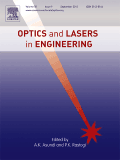
OPTICS AND LASERS IN ENGINEERING
Elevating Standards in Laser and Optical ResearchOPTICS AND LASERS IN ENGINEERING, published by Elsevier Science Ltd, is a premier journal dedicated to advancing the field of optics and laser technology in engineering applications. With a robust ISSN of 0143-8166 and E-ISSN 1873-0302, this journal is positioned within the top quartile (Q1) across several categories, including Atomic and Molecular Physics, Electrical Engineering, and Mechanical Engineering as of 2023, showcasing its prestige and impact in the scientific community. The journal has consistently ranked high in Scopus, notably within the top 10% for Mechanical Engineering and Electronic, Optical, and Magnetic Materials research. Since its inception in 1980, OPTICS AND LASERS IN ENGINEERING has served as a vital platform for disseminating cutting-edge research, fostering innovation and collaboration among researchers, professionals, and academia. Though it does not currently offer Open Access options, its high impact factor and selective publication process ensure that articles reach a wide audience while maintaining rigorous academic standards. Researchers and students alike are encouraged to engage with this influential journal to contribute to and stay abreast of advancements in optical technologies and their engineering applications.

APPLIED MAGNETIC RESONANCE
Exploring the Frontiers of Magnetic Resonance ResearchApplied Magnetic Resonance, published by Springer Wien, stands as a pivotal academic journal within the realm of Atomic and Molecular Physics and Optics. Established in 1990, this journal has become a prominent platform for disseminating high-quality research papers that explore innovative applications of magnetic resonance technologies. With its ISSN 0937-9347 and E-ISSN 1613-7507, the journal is recognized for fostering a deeper understanding of the theoretical and practical aspects of magnetic resonance across various scientific fields. Despite its Q3 ranking in the 2023 Scopus category, it continues to attract a diverse readership interested in advancing the frontiers of physics. Researchers and professionals are encouraged to contribute their findings, as the journal not only enriches academic discussion but also influences real-world applications, making it an essential resource for burgeoning scientists and seasoned experts alike. Additionally, while the journal is not open access, its comprehensive articles can significantly enhance scholarly knowledge and inspire further research in this vital discipline.
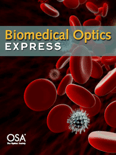
Biomedical Optics Express
Bridging Disciplines with Optical ExcellenceBiomedical Optics Express, published by the prestigious Optica Publishing Group, is an open-access journal that has been at the forefront of the field of biomedical optics since its inception in 2011. With an ISSN of 2156-7085, this journal has established itself as a premier platform for disseminating high-quality research that spans an array of topics in atomic and molecular physics, optics, and biotechnology. As a testament to its scholarly impact, it is currently ranked in the Q1 category for both Atomic and Molecular Physics and Biotechnology, reflecting its commitment to excellence within these disciplines. The journal features cutting-edge articles that foster innovation and collaboration among researchers, professionals, and students who are passionate about applying optical technologies to solve pressing challenges in medicine and biology. Based in the United States, Biomedical Optics Express continues to shape the future of optical science and its applications, inviting contributions that inspire and drive forward the boundaries of knowledge.
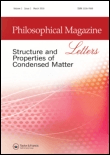
PHILOSOPHICAL MAGAZINE LETTERS
Pioneering Insights in Open Access PhysicsPHILOSOPHICAL MAGAZINE LETTERS, published by Taylor & Francis Ltd, is a prestigious open-access journal dedicated to the vibrant field of Condensed Matter Physics. With an ISSN of 0950-0839 and an E-ISSN of 1362-3036, the journal has been a pivotal platform for disseminating crucial research findings since its inception in 1981. As of 2023, it transitioned to open access, enhancing visibility and accessibility for researchers worldwide. Located in the United Kingdom, it holds a rank of #268 out of 434 in the field, placing it in the 38th percentile for its category. Its recent categorization as Q3 in Condensed Matter Physics reflects its commitment to advancing knowledge through rigorous peer-reviewed articles. The journal welcomes contributions that push the boundaries of understanding in condensed matter, fostering innovation and collaboration among physicists, professionals, and students alike. Explore groundbreaking research and join a community dedicated to the exploration of the fundamental properties of matter.

PROGRESS IN BIOCHEMISTRY AND BIOPHYSICS
Empowering Researchers with Cutting-edge FindingsPROGRESS IN BIOCHEMISTRY AND BIOPHYSICS, published by the Chinese Academy of Sciences, Institute of Biophysics, serves as a vital platform for advancing the field of biochemistry and biophysics. With a legacy dating from 1996 through 2024, this journal has been instrumental in disseminating critical research findings and innovative methodologies that push the boundaries of our understanding of biochemical processes and biophysical phenomena. Though currently unlisted as Open Access, the journal embodies rigorous peer-reviewed scholarship, positioned in the competitive Q4 quartile for both biochemistry and biophysics categories as per the 2023 metrics. It caters to a diverse audience, including researchers, professionals, and students who are keen to explore foundational and emerging concepts within these dynamic fields. By publishing comprehensive studies and reviews, the journal not only highlights progress but also fosters collaboration and dialogue among scholars worldwide, making it an essential resource for anyone invested in biochemical and biophysical research.
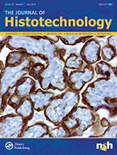
JOURNAL OF HISTOTECHNOLOGY
Exploring the forefront of microscopic analysis and staining techniques.JOURNAL OF HISTOTECHNOLOGY, published by Taylor & Francis Ltd, is a leading academic journal dedicated to advancing the field of histotechnology, which plays a crucial role in both clinical and research settings. With an established history since 1977, this journal serves as a critical platform for researchers, professionals, and students engaged in the intricate study of tissue processing, staining techniques, and microscopic analysis. It is currently indexed in reputable databases, reflecting its commitment to scientific rigor, with a notable presence in categories such as Anatomy, Histology, and Medical Laboratory Technology. Despite its open access status being limited, the Journal of Histotechnology maintains a respectable impact factor and ranks within the third quartile for Anatomy and Medical Laboratory Technology, and fourth quartile for Histology in 2023, emphasizing its relevance in the scholarly community. As the field continues to evolve, this journal aims to foster innovation and dissemination of knowledge within histotechnology, making it an essential resource for those looking to further their expertise and contribute to the advancements in this vital area of health sciences.

Journal of Instrumentation
Unveiling cutting-edge discoveries in measurement techniques.Journal of Instrumentation, published by IOP Publishing Ltd, stands at the forefront of the fields of instrumentation and mathematical physics, playing a crucial role in advancing the knowledge and practice within these domains. With an ISSN of 1748-0221 and an esteemed position as a Q2-ranked journal in both categories as of 2023, it showcases high-quality research and innovative findings that contribute to the broader scientific community. Operating since 2006, this journal facilitates the dissemination of cutting-edge developments and interdisciplinary approaches in measurement techniques and their applications, making it a vital resource for researchers, professionals, and students alike. The journal maintains a competitive edge, ranked in the 59th percentile in mathematical physics and the 35th percentile in instrumentation according to Scopus rankings, reflecting its commitment to quality and impact. With a focus on accessible scientific communication, the Journal of Instrumentation is dedicated to nurturing a collaborative environment that promotes the integration of theoretical advancements and practical issues, providing an essential platform for sharing vital research discoveries.

Biophysical Reviews
Connecting Research and Innovation in Biophysical StudiesBiophysical Reviews, published by SpringerNature, is a leading international journal focused on the interdisciplinary areas of biophysics, structural biology, and molecular biology. With an impressive 2023 impact factor, the journal ranks in the Q1 category for biophysics and is also highly regarded in structural and molecular biology, reflecting its commitment to advancing understanding in these critical fields. Operating since 2009 and converging toward its goal of comprehensive coverage by 2024, Biophysical Reviews provides a platform for researchers to share innovative insights and critical reviews that shape the future of biophysical sciences. Its rigorous peer-review process ensures high-quality publications that are closely monitored within the academic community, making it an essential resource for researchers, professionals, and students aiming to stay at the forefront of biophysical research. Access options are available for enhancing the dissemination of knowledge, supporting a broad audience dedicated to scientific excellence.